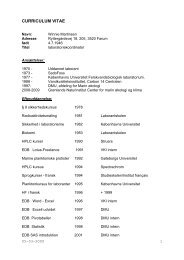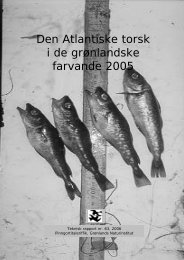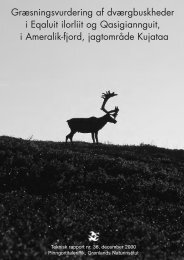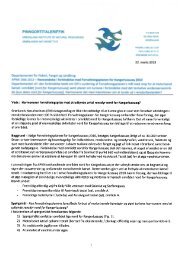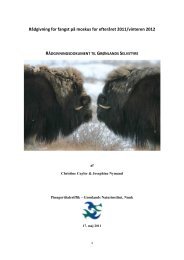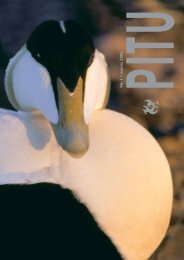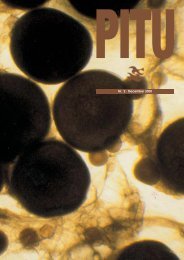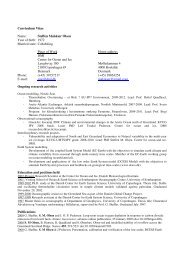Migration and breeding biology of Arctic terns in Greenland
Migration and breeding biology of Arctic terns in Greenland
Migration and breeding biology of Arctic terns in Greenland
Create successful ePaper yourself
Turn your PDF publications into a flip-book with our unique Google optimized e-Paper software.
Figure 5. <strong>Arctic</strong> tern chick fed with polar cod at S<strong>and</strong> Isl<strong>and</strong>.<br />
24<br />
across most <strong>of</strong> West Greenl<strong>and</strong>, where capel<strong>in</strong> constitutes the l<strong>in</strong>k between<br />
zooplankton <strong>and</strong> higher trophic levels (Carscadden et al. 2002; Friis-Rødel<br />
<strong>and</strong> Kanneworff 2002).<br />
At high-arctic S<strong>and</strong> Isl<strong>and</strong>, opportunistic observations <strong>of</strong> prey items carried<br />
by adult birds dur<strong>in</strong>g 2007 <strong>and</strong> 2008 were conducted, along with systematic<br />
observations <strong>of</strong> chick diet <strong>in</strong> 2008 (Egevang <strong>and</strong> Stenhouse 2007,<br />
Egevang et al. 2008). Polar cod (both larvae <strong>and</strong> juvenile fi sh) appeared<br />
to be the most important prey species <strong>in</strong> the chick diet, with crustaceans<br />
(especially Thysanoessa ssp.) as secondary prey items (Egevang et al. 2008).<br />
1.14 Breed<strong>in</strong>g association<br />
Photo: Carsten Egevang.<br />
The <strong>Arctic</strong> tern shows a strong antagonistic, anti-predator behaviour towards<br />
potential predators with<strong>in</strong> the colony boundaries. Both l<strong>and</strong> mammals<br />
<strong>and</strong> avian predators are fi ercely attacked from the air (Hatch 2002).<br />
Shorebirds such as purple s<strong>and</strong>piper (Calidris maritima), semipalmated<br />
plover (Charadrius semipalmatus), <strong>and</strong> red phalarope (Phalaropus fulicarius)<br />
are known to breed <strong>in</strong> higher densities <strong>and</strong> with reduced nest predation<br />
when found with<strong>in</strong> or close to an <strong>Arctic</strong> tern colony (Nguyen et al. 2006,<br />
Smith et al. 2007, Summer <strong>and</strong> Nicoll 2004). In Greenl<strong>and</strong>, Sab<strong>in</strong>e’s gulls<br />
(Xema sab<strong>in</strong>i) breed almost exclusively with <strong>Arctic</strong> <strong>terns</strong> (Levermann <strong>and</strong><br />
Tøttrup 2007), with 21 out <strong>of</strong> 24 colonies found <strong>in</strong> association with tern<br />
colonies. Ross’s gull (Rhodostethia rosea) has only been found <strong>breed<strong>in</strong>g</strong> ten<br />
times <strong>in</strong> Greenl<strong>and</strong>, <strong>and</strong> n<strong>in</strong>e <strong>of</strong> these <strong>breed<strong>in</strong>g</strong> records have been <strong>in</strong> association<br />
with <strong>breed<strong>in</strong>g</strong> <strong>Arctic</strong> <strong>terns</strong> (Egevang <strong>and</strong> Boertmann 2008). At Kitsissunnguit,<br />
there is a strong <strong>breed<strong>in</strong>g</strong> association between <strong>Arctic</strong> <strong>terns</strong> <strong>and</strong><br />
red-necked phalaropes (Phalaropus lobatus) <strong>and</strong> red phalarope (Egevang et al.




